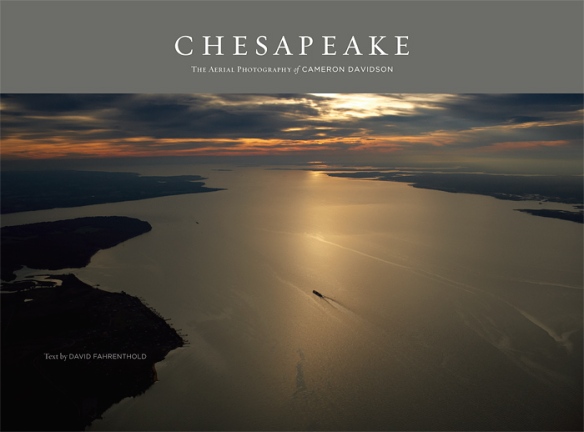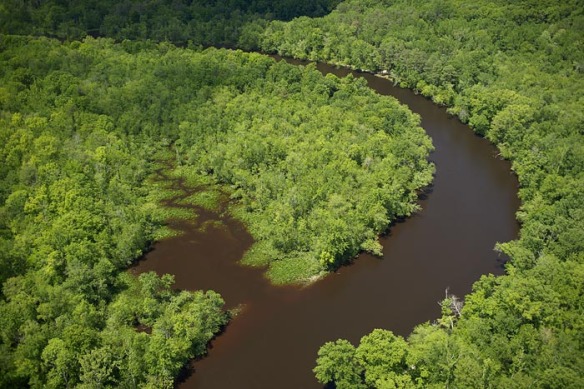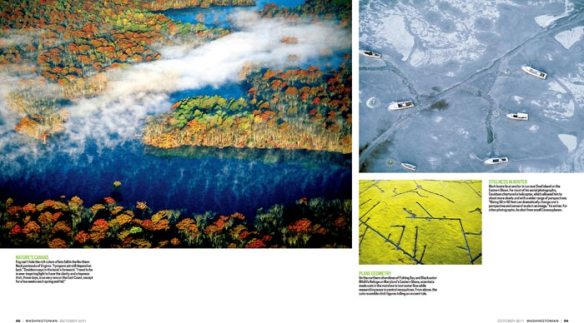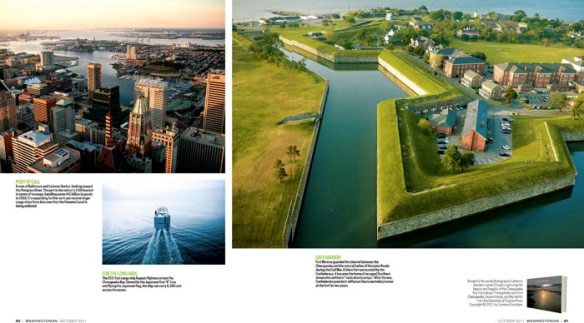Teaser copy of the book. Spreads plus text to give you a feel for the book.
https://www.yousendit.com/download/T2djc2ZKTlExUURsZThUQw
Category Archives: Chesapeake
The Upper Mattaponi River
Image
The Upper Mattaponi headwaters in Virginia. This image was shot a few miles upstream from the Upper Mattaponi Indian property. Aircraft used was a MD 500. The Mattaponi is 103 miles long and its confluence with the Pamunkey river forms the York.
Chesapeake featured in Washingtonian Magazine
Image
Chesapeake is Number 3 on Amazon Travel Photo list
This is pretty wild.
http://www.amazon.com/gp/bestsellers/books/1104/ref=pd_zg_hrsr_b_2_3_last
CHESAPEAKE is number three in sales for Travel Photography books.
All is can say is: wow!
Production Description about CHESAPEAKE.
Product Description
Nearly 10,000 years ago, rising sea levels filled a meteor-impact crater to form the Chesapeake Bay, North America’s largest estuary, and the third largest in the world. The long tendrils of its watershed cover 64,000 square miles and span six states from Virginia to New York. Seventeen million people live within its boundaries. There are more than 100,000 streams, creeks, and rivers in the watershed, including 150 major rivers, with names that conjure ancient voices, such as the Susquehanna, Nanticoke, Mattaponi, and Rappahannock. These waters mix with the Atlantic Ocean in a brackish estuary that helped sustain Native Americans for centuries, but in recent years the bay has come under siege from the impacts of increasing population and industry, threatening this national treasure.
Cameron Davidson has been shooting aerial photography of the Chesapeake over a period of twenty years. The view from this privileged vantage point reveals man’s impact on the land and the water. It yields an abstract beauty that is seldom seen, from the seven bends of the Shenandoah River to the important marshlands and islands of the watershed. Davidson’s lens captures the changing seasons traced from the headwaters of the Susquehanna at Otsego Lake in Cooperstown, New York, to the mouth of the bay at Virginia Beach. Davidson’s poetic pictures bear witness to the bay’s vulnerability and the fragility of its future.
Davidson’s stunning full-color photography is arranged geographically and accompanied by the words of David Fahrenthold, who has written extensively about the Chesapeake Bay and other environmental topics for the Washington Post.
About the Author
Cameron Davidson is an aerial and location portrait photographer based in Virginia. He shoots on assignment for a variety of print publications, including Vanity Fair, National Geographic, and Smithsonian and his work has been profiled in Communication Arts, Photo/Design, and Print magazines. His work has received awards in the Communication Arts Photo Annual, Graphis Photo, Print Design Annual, and the Pictures of the Year competition. He has published five books of photography, including, most recently, Washington D.C. from Above. David Fahrenthold, a native of Houston, Texas, has worked for the Washington Post since 2000. He has covered ther environment, writing about the Chesapeake Bay, climate change, mountaintop coal mining, and other topics both local and national.
Amazon – backordered on the first day
Amazon raised the price and they are back-ordered one day after getting their initial shipment.
They will receive more books this week. All I can say is: wow!
John Harrington has this to say about Chesapeake
Cameron Davidson has taken his vision for a better world to new heights with his latest book – Chesapeake. His stunning visuals provide amazing insights into the beauty and wonder of the Chesapeake bay region. Cameron has taken flight to show the fancy and the mysterious; the awesome power of the water, and the flora and fauna as never before been seen. Even seasoned pilots would be amazed at how Cameron has brought his incredible talent as a photographer to this project and turned what could be boring aerial shots into luxurious portraits of this under appreciated part of the world. What has been clearly a labor of love for many many years now can educate and enlighten you to the wonderment of the Chesapeake.
– John Harrington
Past President, White House News Photographers Association
Amazon Link for CHESAPEAKE
Books arrive this week with Amazon getting their shipment early next week.
If you want to pre-order the book from Amazon – they have a great price!
Writer Extrordinaire Mark Derr says:
Combining his passion for flying, his abiding love for the Chesapeake Bay, and his compulsion to record what he sees–even if it means hanging out the window of a sharply banked single-engine plane–Cameron Davidson has created a magic carpet ride of a book. In these photographs, Davidson presents the Bay through all seasons, at all times of day–though he and his cameras love mornings and evenings best—as no one, I dare say, has done before or is likely to do again. The natural and built worlds that are so often locked in mortal combat stand not juxtaposed but interwoven in a way that shows the complexity and fragility of the Bay today. Whether tomorrow we will continue to use the Bay as a battleground in the war on nature or turn it into a model for a more sustainable and sane way of living on this planet is the primary question underlying this remarkable book.
Miami Beach, Florida







